The RCAF Blackouts were a Canadian World War II entertainment group that performed at airbases in Canada and internationally. [1]
The RCAF Blackouts were a Canadian World War II entertainment group that performed at airbases in Canada and internationally. [1]
The history of the Royal Canadian Air Force begins in 1914, with the formation of the Canadian Aviation Corps (CAC) that was attached to the Canadian Expeditionary Force during the First World War. It consisted of one aircraft that was never called into service. In 1918, a wing of two Canadian squadrons called the Canadian Air Force (CAF) was formed in England and attached to the Royal Air Force, but it also would never see wartime service. Postwar, an air militia also known as the Canadian Air Force was formed in Canada in 1920. In 1924 the CAF was renamed the Royal Canadian Air Force (RCAF) when it was granted the royal title by King George V. The RCAF existed as an independent service until 1968.

The Royal Canadian Air Force is the air and space force of Canada. Its role is to "provide the Canadian Forces with relevant, responsive and effective airpower". The RCAF is one of three environmental commands within the unified Canadian Armed Forces. As of 2020, the Royal Canadian Air Force consists of 12,074 Regular Force and 1,969 Primary Reserve personnel, supported by 1,518 civilians, and operates 258 manned aircraft and nine unmanned aerial vehicles. Lieutenant-General Eric Kenny is the current commander of the Royal Canadian Air Force and chief of the Air Force Staff.

St. John's International Airport is in Newfoundland and Labrador, Canada. It is located 3 nautical miles northwest of St. John's, Newfoundland and Labrador and serves the St. John's metropolitan area and the Avalon Peninsula. The airport is part of the National Airports System, and is operated by St. John's International Airport Authority Inc.

Canadian Forces Base Greenwood, or CFB Greenwood, is a Canadian Forces Base located 1.5 nautical miles east of Greenwood, Nova Scotia. It is primarily operated as an air force base by the Royal Canadian Air Force and is one of two bases in the country using the CP-140 Aurora and CP-140A Arcturus anti-submarine/maritime patrol and surveillance aircraft. Its primary RCAF lodger unit is 14 Wing, commonly referred to as 14 Wing Greenwood.

The Canadair Sabre is a jet fighter aircraft built by Canadair under licence from North American Aviation. A variant of the North American F-86 Sabre, it was produced until 1958 and used primarily by the Royal Canadian Air Force (RCAF) until replaced with the Canadair CF-104 in 1962. Several other air forces also operated the aircraft.

The Canadair CT-133 Silver Star is the Canadian license-built version of the Lockheed T-33 jet trainer aircraft, in service from the 1950s to 2005. The Canadian version was powered by the Rolls-Royce Nene 10 turbojet, whereas the Lockheed production used the Allison J33.
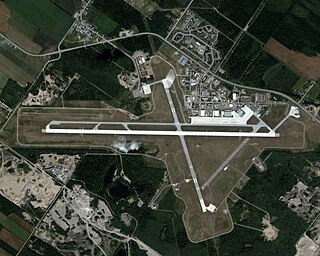
Canadian Forces Base Bagotville, commonly referred to as CFB Bagotville, and also known as Bagotville Airport or Saguenay-Bagotville Airport, is a Canadian Forces base located 4.5 nautical miles west of Bagotville in the city of Saguenay. Located in the centre of Quebec, less than 200 km (120 mi) north of Quebec City, CFB Bagotville is operated as an air force base by the Royal Canadian Air Force (RCAF) and is one of two bases in the country using the CF-18 Hornet fighter/interceptor, the other being CFB Cold Lake. Its primary RCAF lodger unit is 3 Wing, commonly referred to as 3 Wing Bagotville.
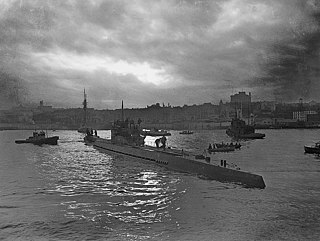
The Battle of the St. Lawrence involved marine and anti-submarine actions throughout the lower St. Lawrence River and the entire Gulf of Saint Lawrence, Strait of Belle Isle, Anticosti Island and Cabot Strait from May–October 1942, September 1943, and again in October–November 1944. During this time, German U-boats sank over 20 merchant ships and four Canadian warships. There were several near-shore actions involving the drop of German spies, or the attempted pickup of escaping prisoners of war. Despite the 23 ships lost, this battle marked a strategic victory for Canadian forces as ultimately they managed to disrupt U-boat activity, protect Canadian and Allied convoys, and intercept all attempted shore operations. This marked the first time that a foreign power had inflicted casualties in Canadian inland waters since the US incursions in the War of 1812.

406 "City of Saskatoon" Maritime Operational Training Squadron is a Royal Canadian Air Force (RCAF) unit of the Canadian Armed Forces. Based at 12 Wing Shearwater since 1972, it is responsible for crew training on the Sikorsky CH-148 Cyclone since summer of 2016. The squadron was formed during World War II as part of RAF Fighter Command.

409 Tactical Fighter Squadron is a unit of the Royal Canadian Air Force. The squadron operates the CF-18 Hornet from CFB Cold Lake in Alberta, Canada.
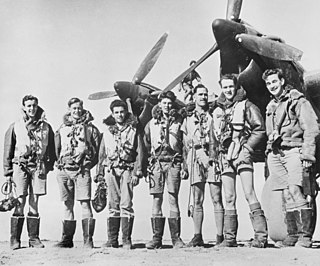
Article XV squadrons were Australian, Canadian, and New Zealand air force squadrons formed from graduates of the British Commonwealth Air Training Plan (1939) during World War II.

No. 428 Squadron RCAF, also known as 428 Bomber Squadron, and 428 Ghost Squadron, was first a night bomber squadron of the Royal Canadian Air Force engaged in strategic bombing during World War II, based in Yorkshire. At the end of the war the squadron moved to Nova Scotia before being disbanded in September 1945. In 1954 the squadron was reformed as 428 All-Weather (Fighter) Squadron, before being again disbanded in 1961.

416 "City of Oshawa" Tactical Fighter Squadron was a unit of the Canadian Forces and the Royal Canadian Air Force. The squadron operated the CF-18 Hornet fighter jet from CFB Cold Lake in Alberta, Canada. In 2006, 416 TFS stood down and was amalgamated with 441 Tactical Fighter Squadron to form 409 Tactical Fighter Squadron.
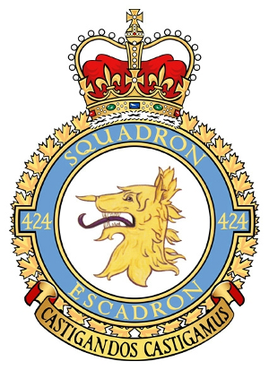
424 Transport and Rescue Squadron, nicknamed "Tiger Squadron", is a Royal Canadian Air Force strategic transport and search and rescue unit based at Canadian Forces Base (CFB) Trenton in the Canadian province of Ontario. The squadron is the primary provider of search and rescue response for the Trenton Search and Rescue Region, which extends from Quebec City to the Rocky Mountains, and from the Canada–United States border to the North Pole, covering an area of over ten million square kilometres in Central, Western, and Northern Canada.
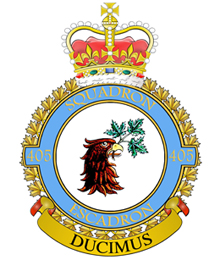
405 Long Range Patrol Squadron is a unit of the Royal Canadian Air Force (RCAF) within the Canadian Forces, initially formed as No. 405 Squadron RCAF during the Second World War.

418 Search and Rescue Operational Training Squadron is a unit of the Royal Canadian Air Force, formed during World War II.

423 Maritime Helicopter Squadron is a unit of the Canadian Forces under Royal Canadian Air Force. It currently operates the Sikorsky CH-148 Cyclone from CFB Shearwater in Nova Scotia, Canada.
RCAF Station Puntzi Mountain is a closed United States Air Force (USAF) and Royal Canadian Air Force (RCAF) General Surveillance radar station. It was located in Canada 200 miles north of Vancouver, British Columbia.